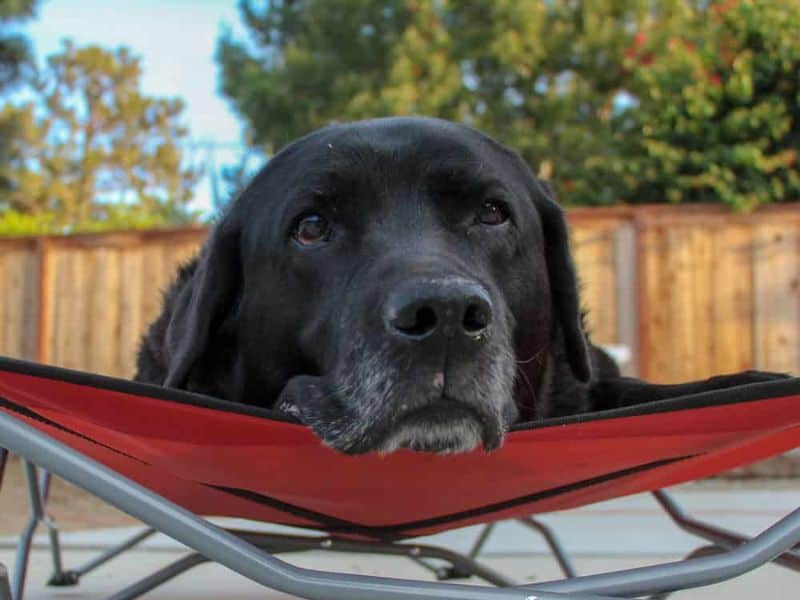This publish might comprise affiliate hyperlinks. We might earn cash or merchandise from the businesses talked about on this publish.
Is the outdated saying that “you’ll be able to’t train an outdated canine new tips” true? No! Outdated canines can be taught new behaviors.
They might have some bodily or cognitive limitations that you must keep in mind. However most older canines like to be taught new issues.
I’ve rescued some grownup and senior canines they usually beloved the eye–and treats–after I taught them new behaviors.

One in every of my rescues, a sheltie named Woman, didn’t even know the way to sit on cue after I adopted her. She was about seven or eight years outdated when rescued.
She had been in not less than three different placements and knew her identify, however that was about it.
One of many first instructions most individuals train their canines is to sit down. New pet dad and mom are normally so proud when their pet learns to sit down on cue.
Sadly, nobody gave Woman any consideration when she was younger apparently.
Woman was the sweetest canine. She beloved everybody–and was in heaven when she was petted and advised what an excellent lady she was.
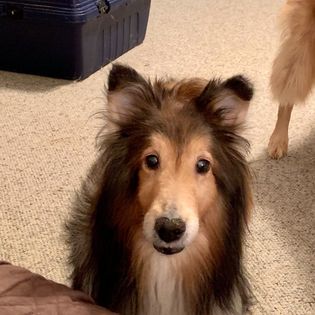
Rescued sheltie Woman paying consideration
After she settled in, we began coaching. She was a fast research.
It was so cute when she realized to sit down on cue. She didn’t lure again, so I captured the habits and rewarded it.
She checked out me as if to say: ”I’ve been doing this all my life. I didn’t know I may get a deal with for sitting!”

Woman sitting on cue
Inside lower than a yr of her arrival, Woman realized all 10 workouts to move the AKC’s Canine Good Citizen check!
A few of the exams concerned sit and down keep, free leash strolling, come, calmly greeting folks and canines, and extra.
She even realized tips and have become a remedy canine who accompanied me to a hospital to consolation sufferers. Woman beamed with pleasure.
Why Educate an Outdated Canine New Tips?
There are numerous causes to show an grownup or senior canine new behaviors.
When you’ve simply rescued the canine, chances are you’ll want to show him even some basic items similar to home coaching. Or for those who’ve had the canine for years, he nonetheless ought to continue learning. Causes embody:
- Instructing a brand new canine essential behaviors. If a canine is new to you, he might have to be taught even primary behaviors similar to home coaching and his identify. And plenty of different cues, similar to paying consideration, sit/down/keep, come, depart it, and the way to stroll on a free leash.
- Selling bodily well being. Instructing obedience cues and tips might help your canine stay bodily wholesome. Relying on the canine’s capability, the trick can contain some bodily exertion. And stretching and transferring might help rejuvenate a canine and maintain his weight down.
- Stopping cognitive decline and tedium. An older canine is extra more likely to undergo from cognitive decline. So giving him one thing enjoyable and difficult to do might help stimulate his thoughts. And it’ll additionally assist forestall him from being bored, simply mendacity round.
- Making ready for a brand new expertise. You might want to coach your older canine when he shall be experiencing one thing new, similar to touring, strolling on a leash in a extra crowded space, or changing into accustomed to a brand new home.
- Furthering your bond. Clearly, you like your canine otherwise you wouldn’t be studying this weblog publish. However whether or not you have got a brand new canine or a long-time greatest bud, coaching can serve to additional your bond. In spite of everything, canines like to be with their pet dad and mom–and the reward and rewards they get whereas studying.
So there are a lot of causes to show your older canine some new obedience cues or behaviors.
Limitations To Take Into Account When Coaching an Older Canine
What you’ll be able to or ought to train the canine depends upon many components. You could keep in mind his bodily and psychological well being.
Older canines might undergo from joint ache or degeneration, arthitis, imaginative and prescient or listening to loss, or a decline in cognitive perform.
So have a full vet check-up earlier than starting a brand new coaching program.
And ask your vet about any limitations your canine might have so as to select the suitable tips for his talents and desires.
Your vet might even suggest a bodily therapist in your pup if he wants it for sure bodily workouts. Or might even present you the way to have your canine stretch previous to them.
In case your canine has cognitive decline, ask about what your canine’s limitations–and talents–are. The identical is true of listening to or imaginative and prescient deficits.
You must also have his tooth checked, as older canines are likely to have dental points, which can have an effect on his talents to do some tips similar to retrieving.
When my senior rescue shih tzu Trevor was shedding his imaginative and prescient, we nonetheless performed scent-work sort video games.
I’d toss some kibble and treats down. And he would fortunately sniff them out and scarf them down. The sport actually perked up his spirits.
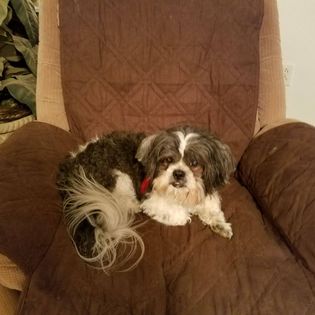
Trevor stress-free
In spite of everything, he was used to being lively. When Trevor was youthful, he was a remedy canine who beloved the eye he obtained. And he used to go together with me to class and was proven in obedience and rally.
However by his previous couple of years, these actions have been too strenuous for him. So he wanted one thing to do or he would have been very bored and sad.
So he regarded ahead to taking part in “discover it” and different video games he was able to taking part in.
There are numerous methods to maintain your canine entertained.
Elements To Think about When Coaching an Older Canine
Apart from the beforehand talked about bodily and cognitive limitations your canine might have, do not forget that there are different issues to keep in mind when deciding on and implementing your coaching program.
How an Older Canine Learns
A 2016 research carried out by the College of Veterinary Drugs Vienna, Intelligent Canine Lab, discovered that canines 10 and older took greater than twice so long as puppies aged six months to a yr outdated to be taught new behaviors.
However it discovered that older canines did retain behaviors that they knew. So the research discovered that canines of all ages retained recognized behaviors.
The research didn’t discover any correlation between canine breed and an ageing canine’s capability to be taught.
However do not forget that, in line with specialists similar to Stanley Coren, completely different breeds are in a position to be taught and retain info at completely different charges.
He rated some breeds as studying at sooner charges and retaining info extra readily. These included border collies, German shepherds, poodles, labrador and golden retrievers, rottweilers, and papillons.
Shih tzus and Lhasa apsos, two breeds that I’ve had for years, are close to the underside of his rankings.
I’ve skilled many breeds and mixes through the years. And I just about agree together with his rankings.
However we’ve to do not forget that canines bred for a working goal–similar to herding, searching, or safety–have been bred to work with us and be taught sure duties.
They usually usually be taught extra shortly than these bred for different functions–similar to being companions.
So my goldens, shelties, and Aussie combine realized obedience instructions and tips fairly shortly with no ton of repetitions.
And my shih tzus and Lhasa apsos took extra repetitions and time to be taught and retain info. So educating “sit” might take 5 repetitions for the working breeds and perhaps 3 times that for the shih tzu.
However my shih tzus and Lhasas did be taught and retain even very difficult behaviors similar to scent discrimination the place she needed to discover a dumbbell I touched amongst others that I didn’t.
My shetties Amber, Duffy, and Murphy realized these fairly shortly and inside weeks have been fairly dependable.
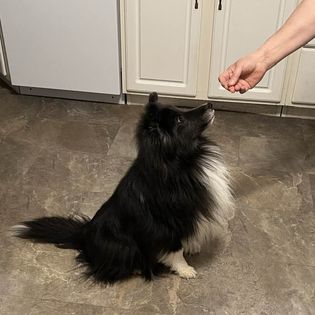
Murphy demonstrating the sit cue
However my shih tzu China took months to turn out to be dependable to find the suitable scented dumbbell–particularly in new, distracting environments.
Have Endurance
In fact canine coaching takes endurance. And coaching an older canine can take extra endurance than coaching a youthful one.
Older canines can take two instances longer to be taught new behaviors than youthful ones do.
So have loads of time in your classes. And admire your canine for who he’s now.
Reward Desired Behaviors
In fact utilizing optimistic reinforcement is the easiest way to coach. Behaviors which can be rewarded will usually be repeated.
However what’s optimistic reinforcement actually? It entails what your specific canine finds reinforcing. And this isn’t all the time treats.
In fact most canines love receiving meals rewards. However there are many different methods to reward your pup.
Reward, play, petting, and experiences he likes similar to occurring a stroll or sniffing in your yard can all be used to strengthen your canine’s habits.
I normally advise beginning with treats and reward. Then you may also transition to different rewards.
So far as treats go, keep in mind to rely them into your canine’s each day energy. Older canines are sometimes much less lively and extra liable to gaining weight.
When coaching my now-senior rescued golden retriever Riley, I do a lot shorter classes than I used to do.
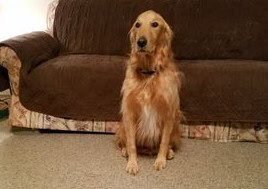
Riley sitting
We even used to do half-hour or longer classes typically when he was youthful and displaying in obedience and rally competitions.
He was very energetic and beloved studying new issues–and making recognized instructions extra exact. My vet even known as him “the wild little one.”
Coaching gave him some impulse management. And he loves it and we bond.
Now, we could do two workouts every coaching session for a couple of minutes complete. I don’t wish to put on him out or bore him.
Do Brief, Constant Classes With Wanted Breaks
Prepare day-after-day if doable. However maintain the classes quick. Take breaks.
Your canine will be taught higher for those who do three quick five-minute classes than one lengthy half-hour session. Most canines be taught higher with quick classes.
Senior canines will usually tire extra simply (relying on breed and well being) than youthful ones.
So chances are you’ll train just one habits per session at first. It might take just a few weeks for him to constantly carry out the brand new trick relying on its problem.
You wish to maintain your canine , not bored. And be careful for indicators of exhaustion, together with:
- Drooping his ears
- Yawning
- Extreme licking
- Boredom, similar to trying away
- Sniffing the bottom
You understand your canine. So that you’ll acknowledge his limitations. Simply cease the session earlier than he disengages.
What Coaching Workouts Are Greatest for an Older Canine?
What you are able to do will rely in your canine’s age and bodily and cognitive limitations.
There are numerous primary and superior behaviors that he can be taught. You simply have to know his limitations and talents.
Some tips that you could be wish to train your pup are:
- The fundamentals. If the canine is new to you or if he doesn’t know primary cues, begin there. Educate him to sit down, lie down, keep, come, free leash strolling, look, and depart it.
- Hand alerts. Instructing hand alerts for behaviors is nice in case your canine isn’t visually impaired. And it’ll actually allow you to talk in case your pup is hearing-impaired. There are some widespread hand alerts you should use.
- Clicker coaching. Utilizing a clicker to mark desired behaviors and inform your canine he carried out appropriately is a good coaching software. Utilizing the clicker can be a solution to train tips to visually-impaired canines.
- Contact. Nostril concentrating on to your hand is a enjoyable trick for many canines to be taught. In case your canine is hand-shy or has impaired imaginative and prescient although, you don’t wish to train this.
- Discover it. Most canines love any sort of nosework. In spite of everything, their sense of odor is extremely developed. I all the time say that they’ve a “nostril mind.”
You may toss about 10 treats and kibble down, scattered, and inform your canine to “discover it.” Or you’ll be able to disguise some within the room and inform him to seek out them.
- Fetch. You may train your pup to take a toy and retrieve it again to you. So long as your canine is bodily in a position to do that, it may be nice for his bodily and psychological enrichment. You will need to first train him to take and maintain the toy.
- Educate the names of his toys and to place them away. In case your pup can retrieve, you’ll be able to train him the names of his toys. Then you’ll be able to train him to hold them to a toy field and drop them in, one by one.
- Shake palms/excessive 5. So long as your pup is bodily in a position to do that, it’s a enjoyable trick that you would be able to showcase to your mates.
- Kiss. You may train your canine to kiss your hand or cheek so long as he doesn’t have any visible or aggressive points. You may put a dab of plain peanut butter or cream cheese and have him lick it off, then add the cue “kiss.”
- Ring a bell. Whether or not you prepare him to ring a bell hanging from a doorknob or one on the ground or wall, this can be a enjoyable trick. You may train your canine to focus on the bell together with his nostril or paw.
- Puzzle toys. Relying on what your canine can do, there are a lot of toys to select from. Snuffle mats are nice for many canines. You set kibble or dry treats within the nooks and crannies in your pup to seek out. It stimulates his pure foraging instincts and nostril mind. Others encourage him to roll the toy or pull or push components to seek out the hidden meals treasures.
- Place. You may train your pup to go to a mattress or mat on cue.
- Spin. So long as he’s in a position, you’ll be able to train your pup to go round in a circle.
- Converse and quiet. You may train your canine to talk and be quiet on cue.
- Rely. After your pup learns to talk and be quiet on cue, you’ll be able to train him to “rely” by giving a cue when to cease talking.
The strategies to show your pup the above cues are present in my article on 21 canine coaching instructions.
In case your canine has a visible or listening to impairment, there are particular methods for coaching canines with these points.
For canines who’re deaf or going deaf, you should use hand alerts and different strategies. And for canines with imaginative and prescient issues, there are particular methods too.
Regardless that all my canines know primary and superior obedience cues, there’s all the time a brand new trick to show them.
I simply taught my golden Riley to nod his head up and down after I ask him if one thing is the reality. It’s a humorous trick that amuses pals.
I taught it by luring his head up and down 3 times with a yummy deal with, praising and giving him the deal with on the finish.
Then I added the cue “fact” after he was used to that movement together with his head.
So the sky’s the restrict relying on what your canine can do.
FAQs
I simply rescued an older canine who doesn’t actually know and instructions. He’s wholesome. However can he nonetheless be taught?
Sure! You may train an outdated canine new tips! Begin with the fundamentals. Educate him his identify, to concentrate, sit, down, keep, and to stroll on a free leash. Begin slowly–one cue at a time.
My outdated canine is shedding his listening to and might’t hear me give instructions he already is aware of like sit or come. What can I do?
You may train him to have a look at you and add hand alerts. Then, you’ll be able to even train him some enjoyable tips.
My older canine is shedding his sight and might’t fetch any extra. Is there any trick I can train him to maintain him completely satisfied and busy?
Sure! So long as he has the cognitive and bodily capability, you’ll be able to train him many tips and supply some enrichment actions for him.
You may lure him with a deal with right into a circle to spin. And you’ll train him a “discover it” cue while you toss some treats close by in order that he can sniff them out. And add puzzle toys to his repertoire to maintain his thoughts and physique lively.
Ultimate Ideas
You may train an outdated canine new tips. You might have to change the way you prepare it or skip some due to his bodily or cognitive talents. However most older canines can nonetheless be taught. And he may have a lot enjoyable and bonding time with you.
Do you have got or have you ever had an older canine that you simply taught tips to?
Please inform us about it within the feedback part beneath.
Save To Pinterest

High Picks For Our Puppies
- BEST PUPPY TOY
We Like: Calmeroos Pet Toy w/ Heartbeat and Warmth Packs – Excellent for brand new puppies. Helps ease nervousness of their new dwelling. - BEST DOG CHEW
We Like: Mighty Paw Naturals Bully Sticks – All of our puppies like to chunk, nip, and chew. We love utilizing Bully Sticks to assist divert these undesirable behaviors. - BEST DOG TREATS
We Like: Loopy Canine Prepare-Me Treats – We use these as our high-value treats for our information canine puppies. - BEST FRESH DOG FOOD
We Like: The Farmer’s Canine – A pair months in the past we began feeding Raven contemporary pet food and she or he loves it! Get 50% off your first order of The Farmer’s Canine.
Try extra of our favorites on our New Pet Guidelines.


